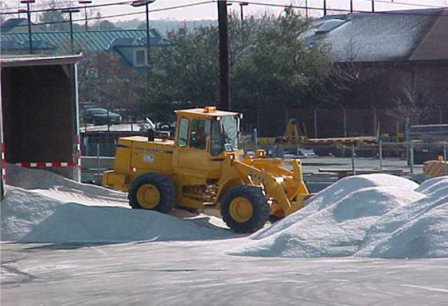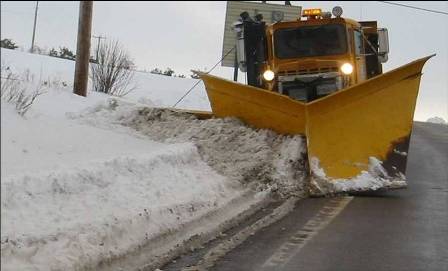|
Click on photo to view larger image




|
Salting snow-covered roads helps keep the traffic, and our economy, moving. But deicing chemicals can threaten public health and the environment – including the water that we drink.
That’s why Maryland is taking steps to cut back on the use of these chemicals. The State Highway Administration has established practices to reduce the amount of salt it applies to roads. Homeowners can also help.
Salt and water
While many look forward to skiing and building snowmen during the winter, snow and ice can make traveling treacherous. Maryland roads are typically treated with deicing chemicals. Maintaining clear roads and highways ensures safe travel and the timely transportation of goods and services that sustain our State’s economy.
The most common chemical used to offset winter conditions is sodium chloride, better known as salt. Salt is an effective deicer, and is inexpensive, readily available and easily stored. But salt can destroy a soil’s structure and produce erosion, can damage and kill vegetation and can contribute to metal bridge and automobile corrosion. In addition, salt can seep into groundwater and can run off into surface water bodies, resulting in contamination of water supplies.
In freshwater streams, this can adversely affect fish, amphibians and insects that are not adapted to those conditions. Since 2010, some stream segments in Maryland have been listed as impaired for chlorides and their effect on aquatic life. MDE and the Maryland Department of Natural Resources have increased monitoring for chlorides to evaluate regional differences and water quality trends. MDE’s Science Services Administration is also developing new standards for chloride in streams to help better assess impairment and protect aquatic life.
Reducing salt in areas near drinking water reservoirs and other drinking water sources is of particular concern. Drinking water reservoirs near highways and salt storage areas can accumulate salt over time. Sodium contributes to cardiovascular, kidney and liver diseases and is directly linked to high blood pressure. Chloride can add a salty taste to water and corrode pipes. Road deicing is the most likely cause of increases in sodium and chloride concentrations in the Baltimore reservoirs since the 1980s.
Plowing ahead
MDE, water resource managers, the drinking water industry and many environmental organizations have been promoting moderate use of salt for road clearing since the 1990s. In October 2012, the Maryland State Highway Administration (SHA) published a Statewide Salt Management Plan that established best management practices for the use of road salt from delivery, storage and handling at salt storage locations to its use during storms and post-storm cleanup. The SHA plan recommends types of deicers and application methods, the manner in which salt is stored, the types of equipment used, training for maintenance staff and planning activities. For example, applying salt brine, which has a lower freeze point than dry salt, prior to the start of a storm can increase safety at the beginning of the storm and prevent snow or ice from bonding to the pavement, which can make it much easier to plow during the storm and reduce the total use of salt. The U.S. Environmental Protection Agency estimates that pretreatment techniques such as this can reduce deicer use by 41 to 75 percent. One significant focus now is on training and raising awareness with State, local and contract employees who handle and apply deicers. SHA holds an annual “Snow College” to educate new maintenance staff and provide a refresher for experienced staff.
Taking action at home
Many Maryland residents use salt to reduce ice accumulation on steps, walkways and driveways. Not only do deicers impact water quality, but they can damage or kill vegetation near the application sites. Harsh chemicals can also be dangerous for children and pets. Tips for reducing or eliminating the use of excessive deicers at home include:
-
Clear walkways and other areas before the snow turns to ice and avoid the need for chemical deicers.
-
Track the weather and only apply deicers when a storm is imminent. If a winter storm does not occur, sweep any unused material and store it for later use.
-
Only use deicers in critical areas and apply the least amount necessary to get the job done.
-
Store deicing materials in a dry, covered area to prevent runoff.
-
Reduce salt use by adding sand for traction, although care is needed to avoid clogging storm drains. Natural clay cat litter also works well for this purpose.
-
If your source of drinking water is from your own private well, avoid applying salt near the well head.
-
Don’t use urea-based fertilizers as melting agents. Runoff can increase nutrient pollution.
The Potomac Drinking Water Source Protection Partnership website includes more information about chemical deicers and the environment.
|
